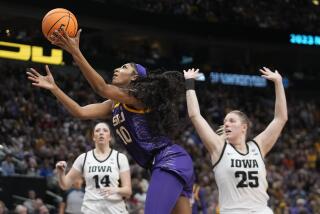Scholar’s ‘Air Ball’ Study Hits Serious Note : Culture: Off-beat research says chant is unusual because it’s spontaneous, in unison, and on pitch, beginning on F and ending on D.
- Share via
JACKSONVILLE, Fla. — The college professor’s findings provoked serious debate among music theorists. They also drew jibes from a humor columnist.
The subject of Cherrill P. Heaton’s scholarly tome? Nothing less than an analysis of basketball fans’ ritual of chanting, “Air Ball! Air Ball!” when a player’s shot hits nothing but air, no rim, not even the backboard.
Heaton’s research showed that the fans’ chant is unusual because it’s spontaneous and begins with fans singing--in perfect unison--”air” on the note F and then dropping down to D when they chant “ball.”
“As any director of a church choir or secular chorus knows, getting a mere 20 or 30 trained singers to sing or chant together and in tune is not always easy. Yet without direction, instruction, a conductor or a pitch pipe, thousands of strangers, massed in indoor stadiums and arenas, are able, if stimulated by an air ball, to chant, ‘Air ball,’ in total and rhythmic unison,” Heaton wrote in his paper, “Air Ball: Spontaneous Large-Group Precision Chanting.”
His research also found that basketball fans always start chanting at the same time--prompted by the basketball’s hitting nothing but air--and consistently remain on key.
But Heaton says his research has provided no clues about how or why this interesting sporting phenomenon takes place.
Heaton’s research was published in the academic journal Popular Music and Society. For the journal, published quarterly by Bowling Green State University in Ohio, Heaton’s article was a natural since the publication focuses on studies of “music in the broadest sense of the term.”
Heaton, an English professor at the University of North Florida, describes himself as a big basketball fan. While watching a game once, he happened to notice how the fans’ “air ball” chant always started on an F and ended on a D.
At first, Heaton thought that maybe he was imagining things, so he began watching basketball games with his pitch pipe in hand. He even videotaped basketball games and replayed the air ball chants.
He forced himself to watch dozens of college games--Kentucky, Duke, Clemson, North Carolina State--to test his theories. They held fast. Then on to the NBA, where once again his theory was proved, although he concluded that pro fans are less likely to chant.
“Perhaps the pro game is viewed by its fans as more serious business than the college game,” Heaton wrote.
He actually did his air ball research in 1990 and it was published in 1992. But he really didn’t get his 15 minutes of fame until this summer when syndicated columnist Dave Barry poked fun at his research. Heaton said Barry called earlier this year and wanted to know if his research was a hoax. Heaton said that, before discussing his important contribution to the scientific study of music, he had to make sure the person calling was really Barry and not a prankster.
“He assured me that he was legit and I assured him I was legit,” Heaton recalled.
The professor said Barry’s column resulted in a thorough discussion of the air ball issue among music theorists.
“It is really a serious question which really nobody, as far as I know, has answered as to how people do that,” he said. “It’s the type of question that a lot of serious scholars are interested in.”
Heaton’s research is so serious, in fact, that serious scholars have been discussing it on no less serious a medium than the Internet global computer network, said Jane Clendinning, an associate professor of music theory at Florida State University.
“Music theorists are usually rather serious folks, particularly about our work, but many of us are also sports fans and the ‘air ball’ discussions have been lively and fun,” said Clendinning, editor of the Society for Music Theory’s on-line computer page.
Philip A. Todd, a doctoral student and teaching assistant at the University of Kentucky, said he originally posted information on Heaton’s research on Internet discussion groups run by the Society for Music Theory and the American Musicological Society.
The air ball discussions have enlivened the staid music groups, which usually discuss the finer points of the classics. “It’s been quite an adventure,” Todd said.
The discussions have pointed out that the same two notes--F and D--are used in other spontaneous chants in American culture.
“In the Army, when guys are jogging along [and chanting], all are at roughly the same pitch. When Darryl Strawberry was with the Mets, they would holler ‘Dar-ryl, Dar-ryl!’ it would start at F and end on D,” Heaton said.
F and D also are the first two notes of “The Star Spangled Banner.”
Heaton, who plays instruments and sings in choirs, even sometimes breaks into spontaneous song while teaching his English class.
“I’ll sing a tune every so often in class if I want to illustrate something,” Heaton said. “I always preface it by saying, ‘I know it’s embarrassing when the teacher insists on singing, but you’ll have to deal with it the best way you can.’ ”
More to Read
The biggest entertainment stories
Get our big stories about Hollywood, film, television, music, arts, culture and more right in your inbox as soon as they publish.
You may occasionally receive promotional content from the Los Angeles Times.










